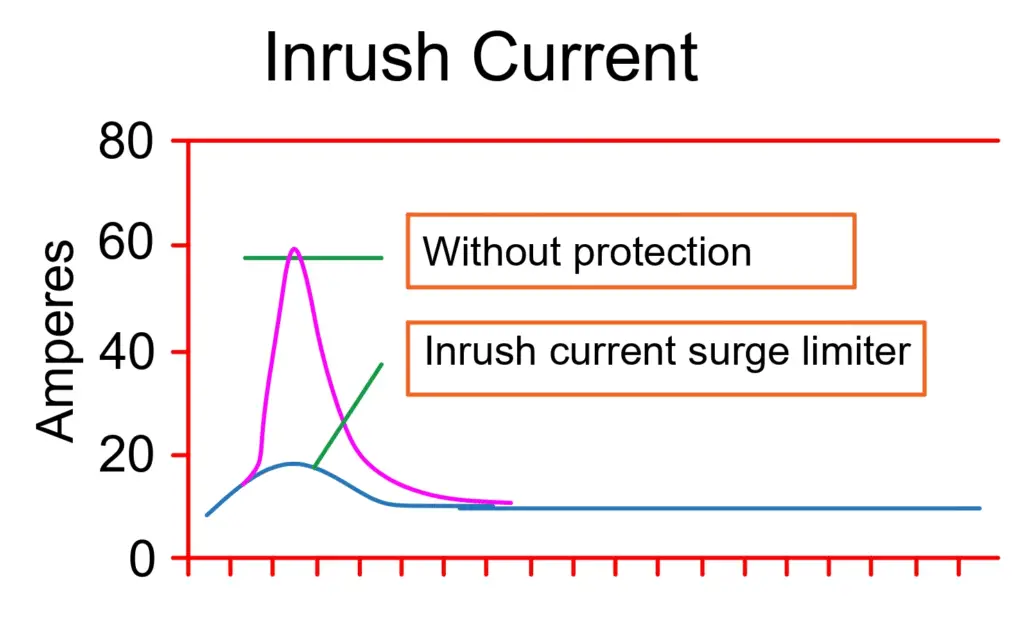Surge current is the abnormally high current drawn by the electrical or electronic devices at startup. After a short period of time, the current returns to normal current. The surge current is also known as the inrush current. The surge current must be restricted because this high current can cause damage to the equipment.
Devices and Equipment that Draws Surge Current
The following equipment draws a high surge current at startup.
- Induction Motor
- Transformer
- Switching Power supplies
- Lighting ballast
The induction motor draws about 6 to 7 times the current of its full load current at startup. Similarly, a transformer draws about 10 times the current of its full load current. The line impedance and the circuit resistance limit the inrush current to a somewhat degree. However, the current above the equipment’s full load current can cause damage to the equipment. Moreover, the high surge current causes the blowing of fuses and tripping of the circuit breaker.
Reasons for Surge Current
Charging capacitors
The capacitors of power supplies, capacitors installed for reactive power management experience inrush currents when the capacitors are initially charged. The capacitor draws an inrush current and quickly builds the voltage across its plates. once the capacitor gets fully charged the current get stabilizes.
Inductive Loads
Inductive loads, such as inductors, induction motors, solenoid valves, transformers, and others draw a large inrush current at startup. The large current sets up the magnetic field and the current reduces once the magnetic field stabilizes.
Switching Power Supplies
The switching power supply (SMPS) has capacitors and a transformer in its circuitry. These components draw an inrush current when the supply is turned on.
Adverse Effect of Surge Current on Electrical System
The surge current cause following adverse effects on the electrical power system.
Circuit Breaker Tripping
The surge current is generally higher than the rated current rating of the circuit breaker. When the inrush current through the breaker exceeds the breaker’s rated current, the circuit breaker gets tripped. If the inrush current exceeds the rated capacity of the circuit breaker, then the protection circuit trips the breaker. The disruption in the power supply causes disruption in the operations of other connected equipment to the electrical system.
Similarly, if the fuses are used they blow out at a large inrush current and cause power disruption.
Overloading of Components
The components, such as capacitors, transformers, and inductors, draw inrush currents. The high inrush current cause excessive thermal stress and equipment may fail because they are not designed for handling high inrush current for a longer period of time.
Voltage Drop
Surge currents cause higher voltage drops. The reduced voltage affects the performance of electrical and electronic equipment.
Electromagnetic interference (EMI)
Surge currents produce more electromagnetic interference. The EMI interferes with the neighboring electronic devices and disrupts the data signal.
Safety hazards
The high surge currents cause excessive heating. leading to the risk of fire. The surge currents can cause power outages.
Prevention of Surge Current
As we discussed above, the inrush currents negatively impact the power system and cause equipment failure. Therefore, it is a must to limit the inrush current for the reliable operation of equipment and power system. The following measures must be taken to limit the inrush current.
Proper Equipment Selection
Choose the equipment or devices that have built-in surge protection features. Here, you should get confirmation from the supplier that the surge protection must not deteriorate the performance of the equipment.
Surge Current Limiters
Surge current limiters are devices installed in series with the power supply to the capacitive or inductive load and control the inrush current. NTC thermistor is used for limiting the inrush current. An inrush current limiter is used in series with the line voltage. At turn on, It has a high resistance to inrush current and quickly removes itself from the circuit, and permits the electrical system to behave normally.

Surge Protectors
Surge protectors, such as metal oxide varistors (MOVs) and gas discharge tubes, divert and absorb excess voltage and current away from sensitive equipment.
Soft-start circuits
Soft-start circuits gradually increase the voltage of a device and limit the initial inrush current. Soft starters are used for induction motor limits the initial high inrush current.